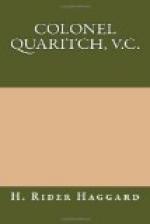And as they built it, so, with some slight additions, it had remained to this day, for in those ages men did not skimp their flint, and oak, and mortar. It was a beautiful little spot, situated upon the flat top of a swelling hill, which comprised the ten acres of grazing ground originally granted, and was, strange to say, still the most magnificently-timbered piece of ground in the country side. For on the ten acres of grass land there stood over fifty great oaks, some of them pollards of the most enormous antiquity, and others which had, no doubt, originally grown very close together, fine upstanding trees with a wonderful length and girth of bole. This place, Colonel Quaritch’s aunt, old Mrs. Massey, had bought nearly thirty years before when she became a widow, and now, together with a modest income of two hundred a year, it had passed to him under her will.
Shaking himself clear of his sad thoughts, Harold Quaritch turned round at his own front door to contemplate the scene. The long, single-storied house stood, it has been said, at the top of the rising land, and to the south and west and east commanded as beautiful a view as is to be seen in the county. There, a mile or so away to the south, situated in the midst of grassy grazing grounds, and flanked on either side by still perfect towers, frowned the massive gateway of the old Norman castle. Then, to the west, almost at the foot of Molehill, the ground broke away in a deep bank clothed with timber, which led the eye down by slow descents into the beautiful valley of the Ell. Here the silver river wound its gentle way through lush and poplar-bordered marshes, where the cattle stand knee-deep in flowers; past quaint wooden mill-houses, through Boisingham Old Common, windy looking even now, and brightened here and there with a dash of golden gorse, till it was lost beneath the picturesque cluster of red-tiled roofs that marked the ancient town. Look which way he would, the view was lovely, and equal to any to be found in the Eastern counties, where the scenery is fine enough in its own way, whatever people may choose to say to the contrary, whose imaginations are so weak that they require a mountain and a torrent to excite them into activity.
Behind the house to the north there was no view, and for a good reason, for here in the very middle of the back garden rose a mound of large size and curious shape, which completely shut out the landscape. What this mound, which may perhaps have covered half an acre of ground, was, nobody had any idea. Some learned folk write it down a Saxon tumulus, a presumption to which its ancient name, “Dead Man’s Mount,” seemed to give colour. Other folk, however, yet more learned, declared it to be an ancient British dwelling, and pointed triumphantly to a hollow at the top, wherein the ancient Britishers were supposed to have moved, lived, and had their being—which must, urged the opposing party, have been a very damp one. Thereon the late Mrs. Massey, who was a




